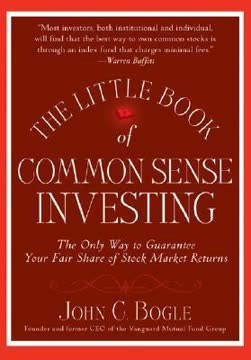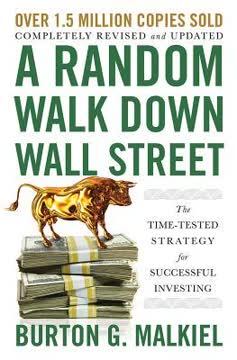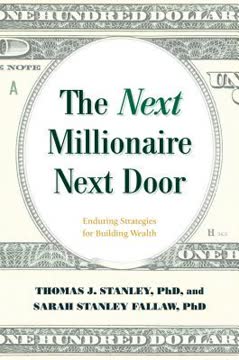Key Takeaways
1. Spend Like You Want to Grow Rich: Mindful Consumption is Key
"Just because someone collects a large paycheck and lives like Persian royalty doesn't necessarily mean he or she is rich."
Wealth is relative. True wealth is having enough money to never work again if you choose, and investments that can provide twice your country's median household income over a lifetime. Many high-income earners are not truly wealthy due to excessive spending and debt.
Live below your means. To build wealth on a middle-class salary, avoid lifestyle inflation and focus on saving and investing. This doesn't mean living like a miser, but rather being mindful of your spending and prioritizing long-term financial goals over short-term gratification.
Avoid consumer debt. High-interest credit card debt can quickly erode your wealth-building potential. Pay off credit card balances in full each month and avoid borrowing for depreciating assets like cars. Instead, save and invest the difference between your income and expenses.
2. Harness Compound Interest: Your Greatest Investment Ally
"Starting early is the greatest gift you can give yourself."
The power of compound interest. Albert Einstein allegedly called compound interest the eighth wonder of the world. When you invest early and consistently, your money grows exponentially over time as you earn returns on your initial investment and on the accumulated returns.
Start investing as soon as possible. The earlier you start, the more time your money has to compound. Even small amounts invested regularly can grow significantly over decades. For example:
- $100 invested monthly at 10% annual return for 40 years = $632,408
- $100 invested monthly at 10% annual return for 20 years = $76,570
Consistency is key. Regular investing through dollar-cost averaging helps smooth out market volatility and takes advantage of compound growth over time. Automate your investments to ensure consistent contributions regardless of market conditions.
3. Low-Cost Index Funds Outperform Actively Managed Funds
"After nearly 50 years in this business, I do not know of anybody who has done it successfully and consistently. I don't even know anybody who knows anybody who has done it successfully and consistently."
The evidence is clear. Numerous studies have shown that low-cost index funds consistently outperform actively managed funds over the long term. This is due to lower fees, broader diversification, and the inability of most fund managers to consistently beat the market.
Fees matter. Even small differences in fees can have a significant impact on long-term returns due to compound interest. Index funds typically have much lower expense ratios than actively managed funds:
- Average actively managed fund expense ratio: 1-2%
- Average index fund expense ratio: 0.1-0.3%
Simplicity and consistency. Index investing provides broad market exposure without the need to try to pick winning stocks or time the market. This approach is simple, low-cost, and has been endorsed by financial experts like Warren Buffett and Nobel Prize-winning economists.
4. Conquer Emotional Investing: Be Greedy When Others Are Fearful
"If you can alter your perspective to be satisfied with what you have, then you won't be as tempted to blow your earnings."
Emotions are an investor's worst enemy. Fear and greed often lead investors to buy high and sell low, significantly underperforming the market over time. Successful investing requires discipline and a long-term perspective.
Embrace market downturns. Instead of panicking during market crashes, view them as opportunities to buy quality investments at a discount. Warren Buffett famously advises to "be fearful when others are greedy and greedy when others are fearful."
Focus on the long term. Ignore short-term market noise and focus on your long-term financial goals. The stock market has historically trended upward over long periods, despite short-term volatility. Maintain a consistent investment strategy regardless of market conditions.
5. Build a Balanced Portfolio with Stocks and Bonds
"Only an irresponsible portfolio would fall 50 percent if the stock market value were cut in half. That's because bonds become parachutes when stock markets fall."
Asset allocation is crucial. A balanced portfolio of stocks and bonds helps manage risk and smooth out returns over time. Stocks provide growth potential, while bonds offer stability and income.
Adjust your allocation over time. A common rule of thumb is to have a bond allocation roughly equivalent to your age. As you get older and approach retirement, increase your bond allocation to reduce portfolio volatility. For example:
- Age 30: 70% stocks, 30% bonds
- Age 50: 50% stocks, 50% bonds
- Age 70: 30% stocks, 70% bonds
Rebalance regularly. Periodically adjust your portfolio back to your target allocation to maintain your desired risk level and potentially boost returns by systematically buying low and selling high.
6. Global Diversification: Invest in International Markets
"With just three index funds, your money can be spread over nearly every available global money basket."
Don't limit yourself to home country bias. Investing solely in your home country's market limits diversification and potential returns. The global economy offers opportunities for growth and risk reduction through international diversification.
Create a globally diversified portfolio. A simple approach is to use three core index funds:
- Home country stock market index
- International stock market index
- Bond market index
Consider emerging markets. While more volatile, emerging markets can offer higher growth potential. However, limit exposure to a small percentage of your overall portfolio due to increased risk.
7. Beware of Financial Advisors' Conflicts of Interest
"The vast majority of financial advisers are salespeople who will put their own financial interests ahead of yours."
Understand advisor incentives. Many financial advisors earn commissions by selling high-fee investment products, creating a conflict of interest with their clients' best interests.
Seek fee-only advisors. If you need professional help, look for fee-only advisors who charge a flat fee or hourly rate for their services, rather than earning commissions on product sales.
Educate yourself. Take control of your finances by learning about investing principles and strategies. With knowledge and discipline, many investors can successfully manage their own portfolios using low-cost index funds.
8. Avoid Get-Rich-Quick Schemes and Market Timing
"Nobody can guarantee those kinds of returns."
Be skeptical of promises. High-yield investments, market timing strategies, and get-rich-quick schemes often lead to significant losses. If an investment opportunity sounds too good to be true, it probably is.
Avoid common pitfalls:
- High-yield bonds ("junk bonds")
- Investment newsletters promising market-beating returns
- Attempts to time the market based on economic predictions
- Overconcentration in trendy sectors or individual stocks
Stick to proven strategies. Focus on building a diversified portfolio of low-cost index funds and maintaining a long-term perspective. Avoid the temptation to chase performance or make drastic changes based on short-term market movements.
9. Rebalance Your Portfolio Regularly for Optimal Returns
"If you rebalance a portfolio like this just once a year, you'll beat 90 percent of investment professionals over time."
Maintain your target allocation. Regular rebalancing helps maintain your desired risk level and can potentially boost returns by systematically buying low and selling high.
Rebalancing methods:
- Calendar rebalancing: Adjust your portfolio at set intervals (e.g., annually)
- Threshold rebalancing: Rebalance when asset allocations drift beyond a certain percentage (e.g., 5%) from targets
- Combination approach: Use both calendar and threshold rebalancing
Tax considerations. Be mindful of potential tax implications when rebalancing in taxable accounts. Consider using new contributions or rebalancing within tax-advantaged accounts to minimize tax impact.
10. If You Must Pick Stocks, Limit It to 10% of Your Portfolio
"No matter what kind of early results you achieve, don't get romanced by the notion that it's going to be easy to beat the market—and don't allocate more than a small portion of your portfolio to individual stocks."
Acknowledge the challenge. Beating the market consistently through individual stock picking is extremely difficult, even for professional investors. Most investors are better off with a diversified index fund approach.
Limit stock picking to 10%. If you enjoy researching and selecting individual stocks, limit this activity to no more than 10% of your overall portfolio. This allows you to satisfy your interest while minimizing potential negative impact on your long-term financial goals.
Follow sound principles:
- Invest in businesses you understand
- Focus on companies with sustainable competitive advantages
- Buy at reasonable valuations
- Hold for the long term
- Diversify across industries and company sizes
Last updated:
FAQ
What's "Millionaire Teacher" about?
- Overview: "Millionaire Teacher" by Andrew Hallam is a personal finance book that outlines nine rules for building wealth, which the author believes should have been taught in school.
- Author's Background: Andrew Hallam is a high school teacher who became a millionaire on a teacher's salary by living frugally and investing wisely.
- Purpose: The book aims to educate readers on financial literacy, focusing on spending habits, investment strategies, and avoiding common financial pitfalls.
- Structure: It is divided into nine rules, each addressing a different aspect of personal finance and investing.
Why should I read "Millionaire Teacher"?
- Practical Advice: The book offers practical, easy-to-understand advice on managing personal finances and investing, making it accessible to beginners.
- Proven Strategies: Hallam shares strategies that helped him become a millionaire, emphasizing the importance of frugality and smart investing.
- Educational Value: It fills the gap left by traditional education systems, which often overlook financial literacy.
- Inspiration: Hallam's story is inspiring, showing that financial independence is achievable even on a modest salary.
What are the key takeaways of "Millionaire Teacher"?
- Frugality is Key: Spending less than you earn and investing the difference is crucial for building wealth.
- Start Early: The power of compound interest means the earlier you start investing, the better.
- Index Funds: Investing in low-cost index funds is recommended over actively managed funds due to lower fees and better long-term performance.
- Avoid Debt: Pay off high-interest debts like credit cards before investing.
How does Andrew Hallam suggest investing in "Millionaire Teacher"?
- Index Funds: Hallam advocates for investing in low-cost index funds as they typically outperform actively managed funds over time.
- Diversification: He recommends diversifying investments across domestic and international stock markets and including bonds for stability.
- Rebalancing: Regularly rebalance your portfolio to maintain your desired allocation between stocks and bonds.
- Long-Term Focus: Emphasizes the importance of a long-term investment strategy, avoiding the temptation to time the market.
What is the "Hippocratic Rule of Wealth" in "Millionaire Teacher"?
- Do No Harm: Hallam suggests adopting a financial version of the Hippocratic Oath, focusing on not harming your financial future by overspending.
- Live Below Means: Spend less than you earn to build assets rather than debts.
- Avoid Instant Gratification: Resist the urge to make impulsive purchases that can lead to financial instability.
- Build Wealth Over Time: Focus on long-term financial health rather than short-term pleasures.
What are the nine rules of wealth in "Millionaire Teacher"?
- Rule 1: Spend like you want to grow rich by living below your means.
- Rule 2: Use compound interest as your greatest investment ally by starting early.
- Rule 3: Small percentages pack big punches; focus on minimizing investment fees.
- Rule 4: Conquer the enemy in the mirror by understanding market psychology and avoiding emotional decisions.
- Rule 5: Build a responsible portfolio with a mix of stocks and bonds.
- Rule 6: Sample a "round-the-world" ticket to indexing by diversifying globally.
- Rule 7: Peek inside a pilferer’s playbook to understand and avoid financial industry traps.
- Rule 8: Avoid seduction by staying away from high-risk investments and scams.
- Rule 9: The 10% stock-picking solution for those who can't resist picking individual stocks.
How does "Millionaire Teacher" address spending habits?
- Frugality: Hallam emphasizes the importance of spending less than you earn to save and invest the difference.
- Needs vs. Wants: He advises distinguishing between needs and wants to avoid unnecessary expenses.
- Avoiding Debt: Encourages avoiding consumer debt, which can hinder wealth-building efforts.
- Mindful Consumption: Suggests being mindful of consumption habits and focusing on long-term financial goals.
What does Andrew Hallam say about financial advisers in "Millionaire Teacher"?
- Conflict of Interest: Hallam warns that many financial advisers prioritize their commissions over clients' best interests.
- Index Funds Over Advisers: He suggests that most people can achieve better results by investing in index funds rather than relying on advisers.
- Educate Yourself: Encourages readers to educate themselves about investing to avoid being misled by advisers.
- Fee-Only Advisers: Recommends seeking fee-only advisers if professional advice is needed, as they are less likely to have conflicts of interest.
What are the best quotes from "Millionaire Teacher" and what do they mean?
- "Spend like you want to grow rich": This quote emphasizes the importance of frugality and living below your means to accumulate wealth.
- "It's not timing the market that matters; it's time in the market": Highlights the importance of a long-term investment strategy over trying to predict market movements.
- "The investment business is a giant scam": Reflects Hallam's view on the financial industry's tendency to prioritize profits over clients' best interests.
- "Avoid seduction": Advises against falling for high-risk investment schemes that promise quick returns.
How does "Millionaire Teacher" suggest handling market volatility?
- Stay Calm: Understand that market fluctuations are normal and avoid making emotional decisions.
- Long-Term Focus: Maintain a long-term perspective and avoid trying to time the market.
- Rebalance Regularly: Use market downturns as opportunities to rebalance your portfolio and buy undervalued assets.
- Diversification: Ensure your portfolio is diversified to reduce risk and increase stability.
What is the "Couch Potato Portfolio" mentioned in "Millionaire Teacher"?
- Simple Strategy: The Couch Potato Portfolio is a simple investment strategy that involves equal allocations to a stock market index and a bond market index.
- Annual Rebalancing: Investors rebalance the portfolio annually to maintain equal weighting, buying low and selling high.
- Low Maintenance: It requires minimal time and effort, making it suitable for those who prefer a hands-off approach.
- Historical Performance: Despite its simplicity, the strategy has historically provided solid returns with reduced volatility.
What are the risks of not following the advice in "Millionaire Teacher"?
- High Fees: Investing in actively managed funds can lead to high fees that erode returns over time.
- Emotional Decisions: Without understanding market psychology, investors may make poor decisions based on fear or greed.
- Lack of Diversification: Failing to diversify can increase risk and lead to significant losses during market downturns.
- Missed Opportunities: Not starting early or failing to take advantage of compound interest can result in missed wealth-building opportunities.
Review Summary
Millionaire Teacher is highly praised for its accessible approach to personal finance and investing. Readers appreciate the clear explanations of index fund investing, the importance of frugality, and the debunking of common financial industry myths. Many found the book eye-opening and life-changing, especially for beginners. Some readers noted repetitiveness in certain sections but overall found the content valuable. The book's global perspective and practical advice on building a simple, low-cost investment portfolio were particularly well-received.
Similar Books








Download PDF
Download EPUB
.epub digital book format is ideal for reading ebooks on phones, tablets, and e-readers.




